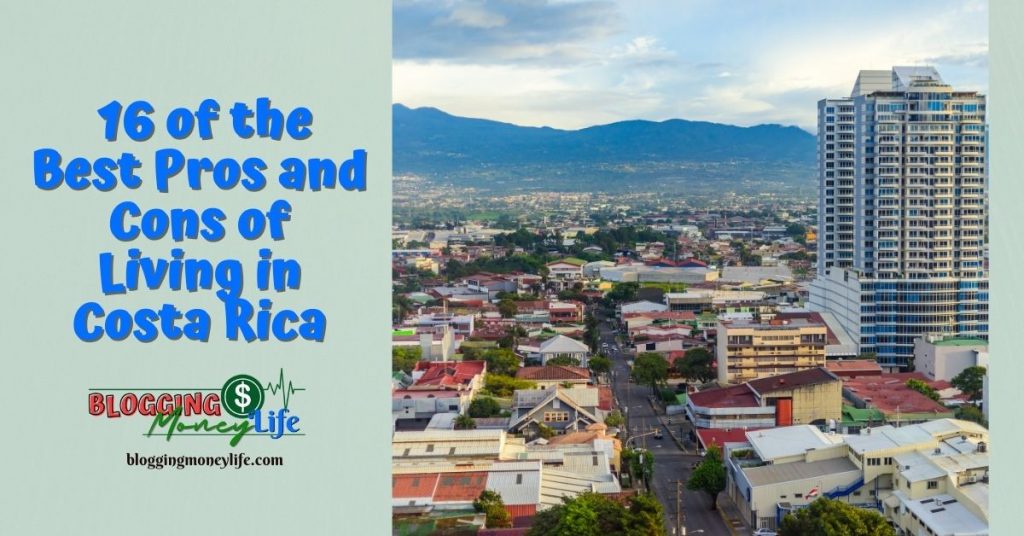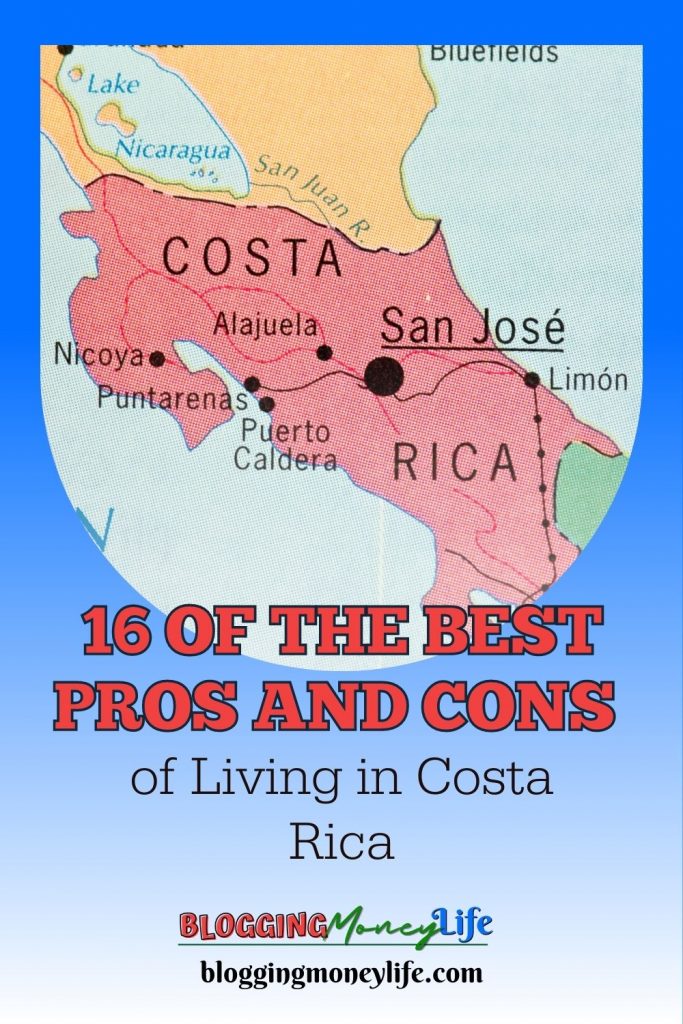16 of the Best Pros and Cons of Living in Costa Rica

With an average temperature of around 75 degrees year-round, this Central American country has been gaining popularity as an ex-pat destination in recent years. As a result, Costa Rica might be the most popular country to live and retire in in Central America. Its warm climate, and beautiful beaches are only two factors that make it attractive to tourists. But what are the pros and cons of living in Costa Rica?
You’ve heard plenty of people talking about the incredible weather, low cost of living, and friendly locals in Costa Rica – but you may be wondering what the tradeoffs might be to living there. Mostly, it’s not always easy to move to another country, especially one with a different culture and history from your own country of origin.
If you’re considering taking the leap and moving to Costa Rica, you’ll want to ensure it’s right for you before committing. As United States citizens that have lived in Costa Rica for about a year now, we want to share our experiences living with Costa Ricans with you – both the good and the bad – so you can decide if it’s the right place for you.
Before we proceed, we would like you to watch one of the videos we made outlining the 10 Reasons why we moved to Costa Rica from the United States.
Are you done watching that? Then, let’s proceed! Here are 16 pros and cons of living in Costa Rica to help you decide if it’s a good place.
Pros of Living in Costa Rica
Here are what you will enjoy while living in Costa Rica!
#1: Great Public Transport
One pro to living in Costa Rica is public transportation. The buses are frequent, inexpensive, and easy to use. You can even pay your fare with a pre-loaded card. However, it’s difficult to compare this form of transport to those in more developed countries like the United States or Europe, where most people drive themselves.

In many rural areas, taking the bus is common sense. However, for foreigners moving here, it’s wise to get a car as soon as possible so that you don’t have to rely on public transport. This will not be an issue if you live in the central valley.
However, if you plan to move to a rural area and need public transport, then you should either buy a car or expect delays due to road closures due to landslides
#2: Modern City Center (San Jose)
Costa Rica’s largest city, San Jose, is a modern metropolis with vibrant nightlife. The public transportation system is easy to use and has some of Central America’s best restaurants and bars. The crime rate is lower than in other cities in Latin America.
There are plenty of great reasons to live here – it just takes a little common sense and planning. But first, you must understand the difference between the central valley (San Jose and Alaujela province) and another tourist area in Costa Rica. There are many good places like malls, parks, and schools in the former.
Public hospitals are also popular places for legal residents and home country nationals because they offer quality health care for affordable rates. Even while they’re not as developed or crowded as the major city center, there are many beautiful spots, and you can find a lot of what you need without driving too far.
#3: One of the Safest Countries
As we said earlier, Costa Rica is a small country with a low crime rate, making it a very safe country. But it is better to be safe than sorry! Other countries in Latin America are safer but not as secure as Costa Rica, making it one of the safest countries for Americans to live in.
Most of the population lives in the central valley and rural areas, which are both safe. The Rentista and Pensionado program offer legal residency options, making them a good place for US citizens. Rural areas tend to have higher crime rates because many rely on growing food for sustenance instead of running a business, so they steal crops from others or money.
The most common crimes are petty theft from cars or homes when owners forget to lock their doors or windows. A common sense idea is not to leave your house unlocked at night. These are the types of precautions we take to stay safe. Other places may have more crime, but these are great reasons why Costa Rica is an excellent place to live.
#4: Affordable Medical Care
Many foreigners have been drawn to Costa Rica for its excellent healthcare and medical needs, which the government subsidizes. In addition, the government provides free health care for those who qualify as legal residents. This makes it an attractive destination for those on a tight budget.

Foreigners who qualify for the rentista program can get even more benefits with reduced costs for private clinics, medicines, prescriptions, and more. Public hospitals in rural areas also provide services at discounted rates to lower-income citizens.
From my own personal experience, I have had great experiences with healthcare here and even had a baby! See my video below on what my experience was like here.
As a beautiful country with relatively few rural areas, most people live in the Central Valley region, with public hospitals and other public services. So, if you need medication or surgery from your doctor, this is a great area to be in. It led us to move from Uvita, Costa Rica, to Escazu.
#5: Tons of Popular Tourist Destinations to Visit
Costa Rica is a small country with tons of natural beauty to explore. One of the most popular tourist destinations is Manuel Antonio National Park, home to two beaches and a rainforest. Other areas worth visiting are the Central Valley and rural areas, where coffee plantations, tropical fruit stands, orchards, and gardens for flowers and vegetables.
The Central Valley has been named by many as one of the best places to live due to its access to amenities and proximity to other parts of the country, such as San Jose, Guanacaste, etc. It is also one of the most beautiful places you’ll see worldwide, while Guanacaste and Nicoya offer fantastic options for great beaches.
#6: Many International Schools
This nation has a lot to offer, one being its vast international schools. It’s a rural country, so it can be challenging for foreigners to find jobs, but many international schools offer high-quality education. With so many international schools, Costa Rica provides an excellent opportunity to study abroad.

So, if you are looking for the best schools with teachers from the USA and other neighboring nations, be sure to find one here in Costa Rica.
#7: You can Visit both the Pacific Coast and Caribbean Coast Without Crossing Borders
Costa Rica has excellent national parks, rainforests, and waterfalls. But if you want to get away from the crowds and the tourists, you can visit the Pacific and Caribbean Coast without crossing borders. Costa Rica is only about 170 miles wide, but it’s a good place for someone who wants to live in one place while traveling between coasts.
#8: Pura Vida Lifestyle
As seasoned travelers, we’ve found Costa Ricans among the most accessible people to get along with. They are friendly, well-educated, family-oriented, and hardworking. A typical Tico has a quick smile and is dedicated to their family and friends above all else.

A pura vida Costa Rican lifestyle. A Costa Rican’s life is synchronized with nature. A vibrant mix of indigenous ancestry and Spanish influence, Costa Ricans are polite, happy, and non-confrontational. Costa Ricans are also known for being laid-back, casual, and friendly.
#9: Different Types of Geography
There are many types of geography, ranging from rural to mountainous regions. Rural areas are generally isolated, while mountainous regions offer scenic views and exciting adventures. The coastal region’s tropical climate makes for perfect living year-round. However, be prepared for heavy rainfall during certain times.
The geography of mountains with hundreds of kilometers of beaches means there is a climate that suits everyone. For those that enjoy hotter weather, head to the beach. Suppose you like the cold; head for the mountains of Cartago or Heredia. Stay in the Greater Metropolitan Area if you want a more temperate climate. Unless you’re searching for snow, you’ll find nearly any environment you could hope for in Costa Rica.
#10: Lower Cost of Living
Whether you stay in the highlands or down on the coast, Costa Rica is not the most expensive country and has a relatively low cost of living compared to certain parts of the US or Western Europe. That country’s availability of quality at an affordable price means that they maintain an above-average standard of living while having a comparatively low cost of living.

The average rent for a one-bedroom apartment in a city center can be less than $500 monthly. You can live cheaply on the outskirts of San José, the national capital, with an average rent of just $350 per month. For an individual living comfortably in Costa Rica, it costs around $1,300 to $1,700 per month.
Again, this largely depends on your choices, but hopefully, you get the idea.
We’ve lived in a few places here, and the rent has definitely varied. In our first place, the rent was only $300 with utilities and internet included, but it was a small shipping container. See the video tour of our first place below.
Where we currently live, we pay $1200 a month and are still responsible for utilities, internet, and water on our own. But we have a lot more space than we did before. See the tour of our current place below.
Overall, it can be very affordable to live in Costa Rica. But it is all a matter of lifestyle.
#11: Rainy Season Instead of Harsh Winters
Though Costa Rica’s tropical area climate is splendid most of the year, during the wet season between May and November, it’s not uncommon to have frequent rains and minor flooding.
The average annual rainfall in this tropical country is 100 inches, with mountainous rainforests receiving the most while the rain level decreases on the Pacific coast and in the northwest. Nevertheless, be mindful that the climates vary widely throughout regions. It is even the case that there are over thirty different microclimates.
Clouds may be gathering and dumping heavy rain in one spot and bright skies in an adjacent region that’s a little far-flung. For example, in September and October, you may have all-day rains in Costa Rica and, on average, experience 17 days of rainfall during those two months.
During that time, the average amount of rain you’ll get is 13 to 17 inches. Unfortunately, those of you living there full-time and with no other options do not have a choice.
But the good side of this is that much of the rain happens in the evenings, so you can still expect sunny days and outdoor ventures even during the rainy season.
#12: Has a Democratic Government
Costa Rica is the oldest democracy in the Americas and one of the region’s most politically stable and neutral nations. The democratic government, with vigorous checks and balances in place, operates as a Constitutional republic with no provincial legislatures.

In Costa Rica, voting is compulsory, but it’s not enforced. This country is well known for its solid environmental efforts, human rights advocacy, and commitment to peace. Given the dearth of military forces and consequent government, Costa Rica makes social support services the focus. In addition to the country’s political stability, it is economically stable.
Due to their strong commitment to sustainable economic growth, this is a wealthy nation of primarily middle-income people that depends on technological innovation and eco-tourism to continue flourishing. A critical contributor to the financial growth strategy is openness to foreign investment and trade liberalization.
#13: Weekly Farmers’ Markets
Weekly Farmers’ Markets are a great way to get fresh produce, especially for those who live in more rural areas. They are also an excellent place to buy souvenirs or other items that may be difficult to find elsewhere. On the downside, some markets are crowded with people and make it challenging to move around, while others can be considered unsafe because they occur in high-crime neighborhoods.
The costs of renting space at a farmers market can also vary greatly depending on where you live. Central Valley residents pay higher prices than their rural counterparts, for example. On the other hand, rural residents typically have lower costs due to lower rents, which is why many people living in the country go to weekly markets instead of shopping at grocery stores.
Cons of Living in Costa Rica
#1: It Takes a While to Get Permanent Residency
Although it’s possible to reside in Costa Rica without a steady job, retirees must still provide proof of adequate savings or a pension. In addition, you can not obtain permanent residency in Costa Rica without first being a temporary resident for at least three years. Getting a residence in Costa Rica can be long and tedious.
Of all the residency options available, the best option is the pensionado or rentista programs, which require applicants to have a $1,000 per month pension or $1,000 in monthly investment income. As a permanent resident, you can apply to the Rentista Program, which will allow you to have a bank account to deposit your pension or retirement income.
However, as we said, it takes time to get permanent residency, so it’s best to start early.
Another thing to note is that there are other programs for temporary residencies, such as the rentista and pensionado programs. These two programs require you to invest money in Costa Rican companies. However, some pros and cons come with these two programs.
We were going through the rentista program initially but were able to get permanent residency pretty quickly after the birth of our son in CR.
#2: Making An International Move is Very Costly
Making an international move is very costly, so you want to ensure it’s the right decision. The price of a move to a new country depends on several factors, the largest of which is where you’re moving to and how much you have to move.

Travel costs, visa fees, and your mover, if you decide to move your properties too, can also influence how much your move costs. To visit a foreign country, you must apply for a visa first. The cost of the ticket can vary depending on the country, the type of visa, and the length of your visit.
Considering how much more you’ll have to pay, visas are only getting more expensive the more people you add. When you factor in more spouses, children, or other relatives, your fees might climb over a thousand dollars. Also, don’t forget the additional costs, so think it through before deciding.
#3: Family Needs a Valid Passport Before Visiting
It is necessary to have a return air ticket when entering Costa Rica. The immigration officer will request one upon arrival. In addition, you should carry a photocopy of your passport with the entry stamp while in the country.
If you’re a family member looking to visit someone who has become a legal resident or citizen of Costa Rica, you need a valid passport before coming to the country. The visitor’s access must be good for at least three months beyond their intended stay.
Generally speaking, how long you can stay in Costa Rica is contingent on what country you are coming from. Immigration officials may also request you prove your economic stability in Costa Rica. Even if you have a 90-day tourist visa, an immigration official can determine how long your stay will be.
Family should also carry documents proving they have been approved visitors by the immigration authorities. Those who don’t comply with these rules risk being fined or detained by immigration authorities upon arrival.
Wrapping Up
Costa Rica is an excellent place to live for many reasons. Public hospitals are among the best in Central America, education is relatively inexpensive, the crime rate is low, and there are many jobs for US citizens.
Many people enjoy living here because it is a small country with rural areas with farms where you can see wildlife and buy produce directly from local farmers. There is also a robust social security and pensionado program, making it easy to retire in Costa Rica.
Overall, Costa Rica is a trendy place to move to if you want an alternative to the United States, but it also has drawbacks. Some downsides include high rental prices, dangerous roads, and mountainous regions outside the central valley. But overall, Costa Rica is an excellent place to live!


Cost of living is very expensive, crime is high in the last years. I suggest you to go and visit the country, I visited Costa Rica three nonths ago.
the cost to live is low in comparative at U.S A,.The government be working strong this year to make the country safe.I travel 2 times in the year,.The personal income always have a influence.
uhhh no. I’ve lived here for 6 months now and the cost of living is NOT cheaper than the states unless you are talking California or the northeast. In fact I am originally from Texas and have found it to be more expensive than the states. You can figure paying 2x to 3x the retail price you would find in the states of most goods (including major appliances and vehicles). Services are vastly cheaper though. Rent is comparable, not less than $500 unless you want to live in a sketchy area. Electricity is much more expensive.
I have been visiting Costa Rica for 20 plus years love its people and their way of life.For the past 15 years we own a home in Grecia in the central valley.The plan was to retire there but…grandchildren and family holds us back but we visit every three months.
que lindo, con lo caro q esta Argentina, mas se viene el invierno, leo CR, seria una linda oportunidad, cual playa? grs sludos Graciela